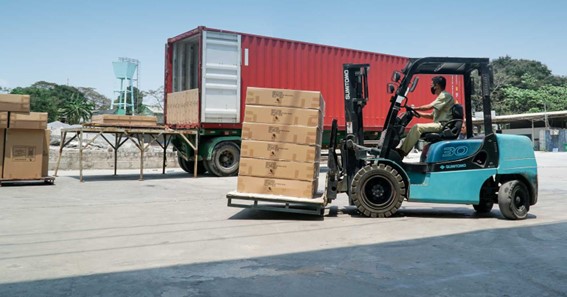Are you curious to know what is dunnage in trucking? You have come to the right place as I am going to tell you everything about dunnage in trucking in a very simple explanation. Without further discussion let’s begin to know what is dunnage in trucking?
In the world of trucking and logistics, the safe transportation of goods is of paramount importance. Ensuring that cargo arrives at its destination in pristine condition requires careful planning and the use of appropriate tools and techniques. One such technique is the use of dunnage. In this blog post, we will explore what dunnage is, its purpose in the trucking industry, and how it helps protect and secure cargo during transit.
What Is Dunnage In Trucking?
Dunnage refers to various materials, typically wooden or plastic, used to protect and stabilize cargo during transportation. It serves as a cushioning and support system that helps prevent damage caused by vibrations, impacts, shifting, or moisture. Dunnage materials are strategically placed within the cargo space of a truck, creating barriers, filling gaps, and providing additional support to ensure the safe transport of goods.
The Purpose Of Dunnage In Trucking
- Cargo Protection: The primary purpose of dunnage is to safeguard cargo from damage or breakage. By creating a buffer between items and the truck’s walls, floor, or other cargo, dunnage absorbs shocks and vibrations that may occur during transit. This helps prevent shifting, rubbing, or impact-related damages that could compromise the integrity of the goods.
- Load Stability: Properly securing the load is essential to maintaining stability during transportation. Dunnage materials, such as wooden blocks or bracing, can be strategically positioned to fill gaps, stabilize irregularly shaped cargo, or create barriers between different types of goods. This helps prevent shifting or movement that could lead to imbalances, which may affect the truck’s handling or compromise the safety of the driver and other road users.
- Moisture Control: Dunnage can also play a role in managing moisture within the cargo space. Moisture-absorbent materials, such as desiccant packs or moisture barriers, can be used to protect goods from condensation or humidity that could cause damage or spoilage. By maintaining the appropriate moisture levels, dunnage helps preserve the quality and condition of the transported goods.
Types Of Dunnage Materials
- Wood Dunnage: Wooden dunnage, typically made from lumber or plywood, is commonly used in the trucking industry. It is versatile, readily available, and provides excellent support and cushioning. Wooden blocks, pallets, or braces can be used to secure cargo, fill voids, and create partitions within the cargo space.
- Plastic Dunnage: Plastic dunnage materials, such as air-filled cushions, foam inserts, or plastic pallets, offer lightweight and moisture-resistant alternatives. They are particularly useful when transporting goods that require protection from moisture or when weight reduction is crucial.
Best Practices For Dunnage Application
- Proper Placement: Dunnage should be strategically placed to provide support and stability to the cargo. This involves analyzing the shape, size, and weight distribution of the items being transported and using appropriate dunnage materials accordingly.
- Secure Fastening: Dunnage should be securely fastened or braced to prevent movement or shifting. Using straps, ropes, or securing devices helps hold the dunnage in place and prevents it from becoming a hazard during transportation.
- Regular Inspection: It is crucial to regularly inspect dunnage materials for wear, damage, or deterioration. Damaged or ineffective dunnage should be replaced promptly to maintain the integrity and safety of the cargo.
Conclusion
Dunnage plays a vital role in the trucking industry, ensuring the safe transportation of goods from point A to point B. By providing protection, stability, and moisture control, dunnage materials help prevent damage, shifting, and spoilage during transit. Proper application and use of dunnage materials are essential for maintaining cargo integrity, driver safety, and customer satisfaction. So, the next time you see a truck loaded with goods on the road, remember that behind the scenes, dunnage is silently working to safeguard the valuable cargo within.
Get Knowledge About Different Topics On Sizesworld
FAQ
What Are The Three 3 Types Of Dunnage?
Dunnage types
- Solid dunnage materials. These materials are used for heavy cargo.
- Soft dunnage materials. Soft dunnage options are used when transporting lightweight and small packages.
- Paper-based dunnage materials. These materials are also used for lightweight cargo.
- Custom dunnage solutions.
What Does Dunnage Mean On A Flatbed?
Dunnage is a shipping terminology that describes packaging supplies, such as bubble wrap, kraft paper, crinkle paper, planks, blocks, and boards to support and secure packages during shipping. In the pick and pack process, dunnage is typically used to help protect the products from damage and shifting around.
What Are The Duties Of Dunnage?
The main functions of dunnage are:
- Protection against sweat and condensation water.
- Protection against moisture and liquids.
- Protection against soiling and contamination.
- Protection against mechanical damage.
Why Do They Call It Dunnage?
Etymologists don’t know the exact origin of dunnage. Some have pointed out the similarity of the word to dünne twige, a Low German term meaning “brushwood,” but no one has ever proven the two are related.
I Have Covered All The Following Queries And Topics In The Above Article
What Is Dunnage Racks In Trucking
What Is Dunnage Wood
Types Of Dunnage
Dunnage For Flatbed
What Is Dunnage In Construction
Dunnage Paper
Why Is It Called Dunnage
Dunnage Rack Meaning
What Are The 9 Types Of Dunnage
What Is Dunnage In Trucking
What does dunnage mean in trucking

12 thoughts on “What Is Dunnage In Trucking?”
Comments are closed.